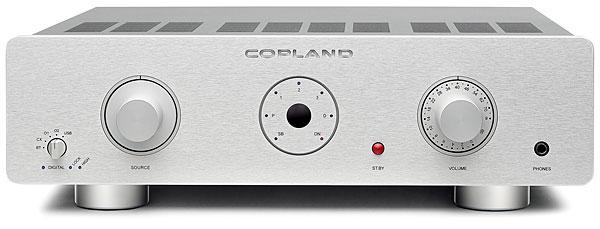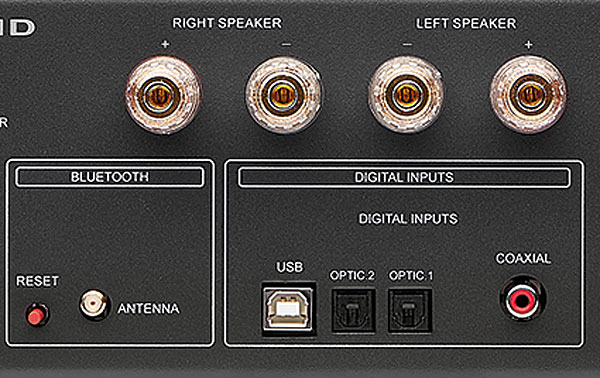Copland CSA70 Integrated Amplifier

 Hot on the heels of its tube hybrid integrateds comes this altogether cooler solid-state amplifier from Danish brand Copland. It packs on the style while also packing a punch
Hot on the heels of its tube hybrid integrateds comes this altogether cooler solid-state amplifier from Danish brand Copland. It packs on the style while also packing a punch
Nothing causes more consternation than a product seemingly 180 degrees at odds with a company's core philosophy, whether hi-fi, cars, watches, what-have-you. Audio Research dealt with the repercussions of its first solid-state amp… but an all-transistor amp from the equally tube-centric Copland? Not its first – these were the mid-'90s CSA8/CSA18 – so the CSA70 probably won't cause too much of a ruckus despite the absence of bottles.
Either way, like Japan's sublime Air Tight and other mystifyingly low-key brands, Copland merits greater fame. Undoubtedly, this £2988 unit could serve perfectly as an intro to the brand and is ideally suited to those considering new hardware at mid-level. Offered in silver or black, an MM phono stage wisely included, it lacks nothing but balanced inputs, while the Bluetooth/Wi-Fi option (£198) – not present in the review sample – further broadens its appeal to those weaned on tablets and mobile phones.
Brick By Brick
There's a degree of future-proofing too, the spec including pre- and line-outs so you can expand it with a second amp, upgrade a stage at a time, incorporate it into a home cinema, or fit a tape deck. It'll host digital sources via coax, Toslink or USB while its remote control will also deal with Copland's legacy CD players.

The CSA70, however fully-loaded it may be, is so sensible that it's worthy of being described as being as Danish as Lego. Its styling – clearly modelled on Copland's larger CSA100 and CSA150 hybrid tube/transistor amps [HFN Aug '20 and Jun '21] – is so clean as to be exceptionally easy on the eye, such that anything sitting next to it looks virtually rococo.
Functionality? Beyond reproach save for the aforementioned lack of balanced XLR inputs, but that's hardly a fatal omission. Under the bonnet, the transistor output stage bears some similarity with that premiered in the CSA100 and '150 although their triode preamp stages are traded here for a wide-bandwidth solid-state circuit. The digital section is tailored to the CSA70 too, with a Cirrus rather than ESS DAC.
Across the front, the CSA70 presents a face that's nearly self-explanatory. I say 'nearly' because the labelling on the rotary at the lower left-hand corner may seem arcane, but not to anyone who uses digital sources. As this is relatively affordable, it might find its way into the systems of hi-fi novices, who will need to refer to the owner's manual, but the rest of you will immediately decipher the settings to represent Bluetooth, Coax, Optical 1 and 2, and USB, while three LEDs below indicate its operational status.

Light Music
A large rotary on the left of the amp's fascia selects the sources while level is set by a motorised, analogue control on the far right. In the middle is an 'early iPod'-styled display indicating the selected input. It lights up, clockwise, for standby (a red button to the lower right of the display accesses this state of rest, which is – but of course! – labelled 'ST.BY'), phono (a 'P'), and three line inputs indicated by numbers. Selecting a digital source ('D') lights up the LEDs in the lower left corner, but the 'D' only illuminates when the optional Bluetooth module is present. Lastly, there is a 6.35mm headphone socket, which mutes output to the loudspeakers.
A mix of clarity and abundance, the feature-packed back panel somehow maintains the Scandinavian obsession with minimalism. Despite the plethora of socketry, it, too, is self-explanatory to the seasoned audiophile, with RCA phono sockets on the left for
pre-out/line-out, next to a pair for phono with an earthing post above, followed by three sets of sockets for the line inputs.
Next to these is a post for the Bluetooth aerial and a reset button, which come fitted whether or not the optional internal module has been purchased, followed by digital inputs for USB, coaxial and two optical. Above them are multi-way speaker binding posts, plus the main on/off power switch and an IEC three-pin mains socket.
![]() Like Danish Pastry
Like Danish Pastry
There is no drama at all with the CSA70. It worked perfectly from the start, and my intuition didn't fail me in figuring out the connections. Assorted inputs aside, I was more interested in determining the overall character of the unit, so I stuck with CD via the optical input and the MM phono stage fed with Decca and Ortofon cartridges. The lack of an MC input is easily addressed if the CSA70 leaves you strapped for cash by any number of sub-£200 phono amps.

















































